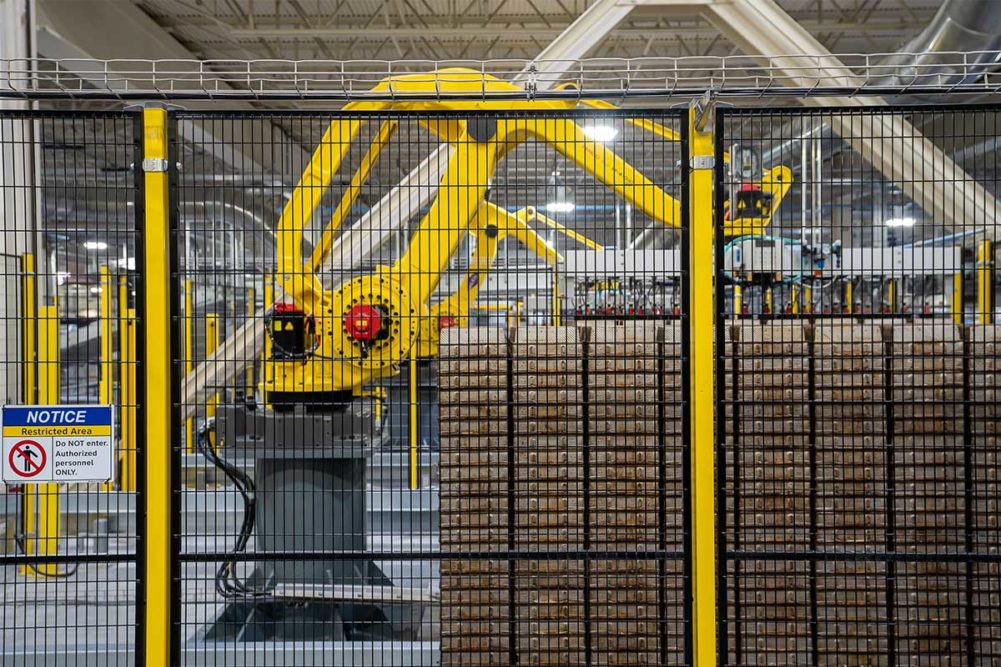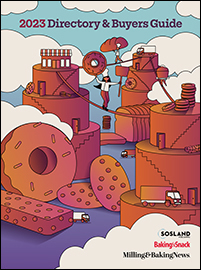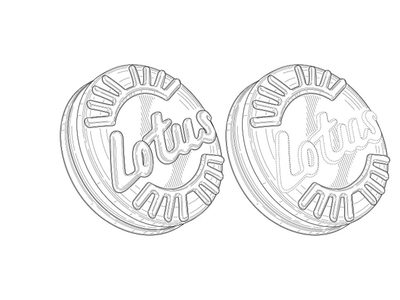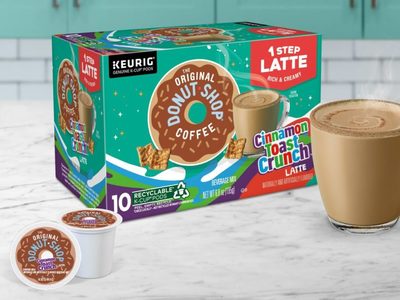The bounty of open production space available in Flowers Baking Co. of Henderson, Nev., offered Flowers Foods, Thomasville, Ga., an opportunity to design an extremely automated production line for Dave’s Killer Bread (DKB) production. Everything on the DKB production line is new. Robert Benton, recently retired executive vice president of network optimization for Flowers Foods, and his team took the opportunity to hone in on the details to make the new line reach optimal efficiencies. Seemingly minor moments in production where human hands typically are involved in the process were eliminated in an effort to open up capacity and reduce costs.
“This bakery is unique,” Mr. Benton said. “The bakeries that this team grew up in, they had to throw minors and micro ingredients into the front of the mixer. You don’t do that here. Ergonomically, this bakery is much better.”
All ingredients are automatically scaled, bulk, minor and micro. The auto-scaling system for micro ingredients deposits them into a bucket that travels under the system by conveyor. Based on the recipe, the bucket stops under the appropriate screw auger and a load cell weighs out the appropriate amount.
“We’ve seen the results of people making mistakes by manually scooping and weighing these ingredients,” Mr. Benton said. “It’s a wonderful piece of equipment because that all goes away. Our design thought process for this line was having a set of systems for major ingredients like flour, oil and sugar, and then super sacks for the next level of usage, and now we have the minor system.”
The system does the work of three people across 24 hours in 6 hours with only one person.
The need for people to handle pans has also been eliminated. With the amount of space available, Flowers Foods invested in robotic pan handling. Two Fanuc robots from Weldon Solutions stack and unstack pans as they enter and leave production. As pans leave — or are recycled back into production — a pan cleaner from AMF Bakery Systems flips the pans over and wipes out any leftover debris from the loaves that were just removed. Another differentiator in Henderson, empty pans are not flipped back upright until they are ready to receive dough. The pans travel throughout the plant upside down not only for food safety but also for pan life.
“When pans run on a conveyor in what we consider ‘the normal way,’ the slip and wear is directly on the cylinder that’s carrying the loaf of bread,” Mr. Benton said. “Bundy Baking Solutions worked with us on changing the band designs so we could run them upside down, which makes them last a lot longer.”
The rim of the pan, he explained, is the strongest part, rather than the bottom, so by letting the rim bear the weight of the pan as it travels empty throughout production, wear is reduced. This, however, did cause challenges in how the pans traveled through the system.
“Figuring out how to get them to run smoothly through the system was one of the most difficult details of our unique setup in Henderson,” said Robert Ray, vice president, network optimization project management for Flowers Foods. “Collaboration between all our vendors was critical to finding the right way to achieve our goal.”
Another way Flowers Foods reduces wear on this production line is by turning the pans to run wide rather than narrow — which was its own puzzle to solve — allowing the bakery to run the line slower without losing throughput. Or as Mr. Benton put it, “go slow to go fast.”
“When you run the pans the narrow way you extend the length of the cooler, and the pan conveyors run very fast. The wear factor on the equipment is much greater when you go the narrow way,” he said. “By going the wide way, we can run slower while getting more tonnage through the system, which is easier on the equipment. This is where guys like Brandon Brilliant [general manager at AMF Bakery Systems] come in. They listened to our concerns and made adjustments; they were really in touch with what we were trying to accomplish here.”
Flowers Baking Co. of Henderson is a 24/7 operation. Each line runs six days with alternating down days for sanitation and maintenance. This prevents all three lines from being down at the same time. The DKB line, however, currently only runs two shifts with capacity to run a third.
“This line is capable of running many more pounds per hour than most of our other DKB lines; it’s our largest line to date,” Mr. Benton said.
Orders come in a day ahead of time and are baked the next day and shipped out as quickly as possible to customers’ distribution centers because the product goes out fresh, not frozen.
“Our DKB products go a little farther than some of the conventional products, so we have to get a little bit ahead of making sure those trucks get out on the road,” explained Jesse Bonner, production manager at Flowers Baking Co. of Henderson.
The Henderson facility is fed by seven cylinders with one split: three silos with a capacity of approximately 174,000 lbs, three with approximately 200,000 lbs of capacity and the split silo capable of holding 60,000 lbs on each side. Four of the silos feed the conventional production lines, while the other four contain organic wheat and white flour for the new DKB line. Automated ingredient handling for silos, supersacks and liquid minor ingredients are scaled and added directly to one of three Shaffer horizontal mixers, which can each hold 2,600 lbs of dough. Once dough is mixed, an automated chunker is summoned by the mixer to receive the dough. The dough is released into the trough, chunked and delivered to the AMF Bakery Systems seven-pocket divider, cone rounder and two moulders via overhead Shaffer conveyor.
Dough balls are transferred by conveyor to one of two AMF Tromp sheeting lines where they will be sheeted and chain rolled into their loaf form. After being enrobed in seeds, the loaves are dropped into awaiting Bundy pans.
After gaining the rise they need in the AMF continuous proofer, the loaves travel through the jewel of the Henderson facility: the 200-foot AMF direct gas-fired tunnel oven.
“I’ve always wanted to put in one of these big tunnel ovens, and we finally had the space. From every perspective — maintenance, quality, sustainability — every perspective, it’s an amazing piece of equipment,” Mr. Benton said. “If we had the real estate, we would put these ovens in every bakery.”
The oven is better insulated too, ensuring most of the heat goes into the product rather than leaking into the bakery.
When the loaves exit the oven, bread is depanned by a Capway Automation system and travels wide way up the mezzanine where an ambient cooling spiral awaits. The pans stay on the main floor to be cleaned and flipped upside down by the AMF pan cleaner. An air jet and double brushes remove any remaining particulates and seeds from the previous bake and then the pans travel upside down to pass under the AMF pan cooler, which removes the heat coming off the pans as quickly as possible.
“It takes a lot of heat out of the bakery too rather than traveling that hot pan all throughout the bakery as it cools,” Mr. Benton explained. “The quicker you can cool a pan, the better off you are.”
Once cooled, pans are either sent back into production or robots re-stack them for storage. With the implementation of robotic pan stackers/unstackers, the bakery was able to eliminate the need to hire three to four people to perform this heavy-lifting task.
While pans are processed, the bread loaves cool for 100 minutes. Bread loaves exit the cooler six wide and are sorted back into single file before entering the packaging department. Bettendorf Stanford slicers on each line slice the loaves before moving through the Bettendorf Stanford single baggers. Burford twist ties close the first bag before sending it through the Bettendorf Stanford double baggers. A Kwik Lok closure seals the second bag. Every packaging line servicing DKB production can handle both single-bagged and double-bagged product.
Once bagged, an AMF Versa Loader on each line orients the product into trays. A robotic arm picks up three bags at a time and places them in a tray, a task that would otherwise take five to six people per line. This set up only requires one person who monitors these machines while attending to other tasks.
Once bread is loaded onto trays, it’s ready to head off to one of the many customers Henderson serves.
This article is an excerpt from the July 2023 issue of Baking & Snack. To read the entire feature on Flowers Foods/DKB, click here.






